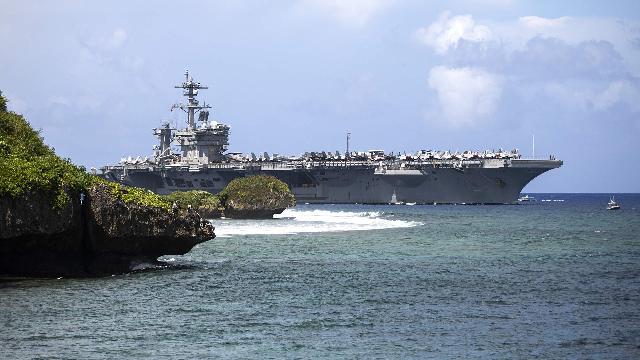The US Navy is increasing its combat capabilities in the Middle East region and what can Tehran oppose them?
The United States is sending aircraft carriers and other ships to the Middle East region. It is not yet known whether the American fleet will enter into a conflict between Israel and Iran, but this cannot be ruled out. What kind of naval forces do the Americans have in the region, what combat capabilities do they have and what the Islamic Republic can oppose them — in the Izvestia material.
What forces does the United States have in the Middle East region
Since 1996, the US 5th Operational Fleet has been responsible for operations in the Persian Gulf, Red and Arabian Seas. Its headquarters and main base is Manama Base, located on the island of Bahrain. This is precisely the operational fleet, that is, it has permanent headquarters and logistics structures. The ship's composition is a variable component. There are several ships and auxiliary vessels based in Bahrain, including minesweepers and the Canberra coastal zone ship. After the outbreak of hostilities, the United States withdrew its forces from their permanent bases in the Persian Gulf. And they have deployed additional forces in the region.
In particular, the aircraft carrier strike force with the aircraft carrier Chester Nimitz passed the Strait of Malacca on June 16 and headed for the northern part of the Arabian Sea, where it is expected to arrive on June 22. In addition to the aircraft carrier, it also includes the destroyers Curtis Wilbur, Gridley, Wayne Meyer and Lena Sutcliffe Higby. A group led by the aircraft carrier Carl Vinson and its supporting ships, the cruiser Princeton, the destroyers Sterett and William P. Lawrence, is already operating in this sea. There are two destroyers operating in the Red Sea, the Forrest Sherman and the Trakstan. The destroyer Ralph Johnston is based in Diego Garcia.
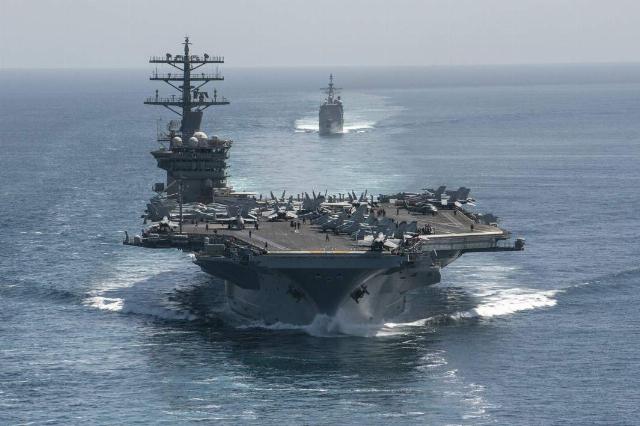
The American aircraft carrier Chester Nimitz in the Indian Ocean
Image source: Photo: Global Look Press/US Navy
There are no combat groups with amphibious ships in the Indian Ocean area. Nothing is known about the presence of US nuclear submarines, but there is no doubt that they are heading at full speed to their assigned patrol areas.
The following destroyers are noted in the Mediterranean Sea in the waters between Israel and the island of Crete (where the Ship is based): Sullivan, Arleigh Burke and Thomas Hudner. They participate in repelling Iranian raids and replenish their supplies on the Court. Two more destroyers were urgently deployed to the area: after completing six months of combat service, Oscar Austin intended to head home to the Rota base in Spain, but rest and repairs were canceled, the ship went back. After leaving the Baltops-2025 exercise site, the destroyer Paul Ignatius is heading to the Mediterranean Sea. Thus, today there are already five destroyers of the 6th Fleet of the US Navy in the Eastern Mediterranean (in the area from Cyprus to Port Said).
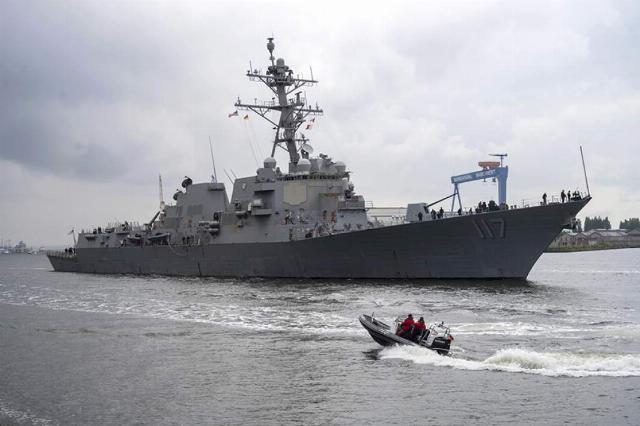
The American destroyer Paul Ignatius at the Baltops-2025 exercises
Image source: Photo: TASS/dpa/picture-alliance/Stefan Sauer
Another aircraft carrier group, led by the aircraft carrier Gerald Ford, will leave its base in Norfolk next week and will arrive at the shores of Israel no earlier than July 10.
That is, everything that could be assembled from naval forces in the regions of the Eastern Mediterranean or the Arabian Sea has already been assembled and is ready for combat operations.
The U.S. Navy currently includes only Arleigh Burke-class destroyers of several series. The main armament of these ships is a vertical launcher for various types of anti-aircraft missiles, cruise and anti-submarine missiles. Depending on the series, the destroyer can carry 90 or 96 missiles in various combinations. Coupled with the Aegis radar fire control system, such a ship is capable of effectively conducting air defense against various types of missiles.
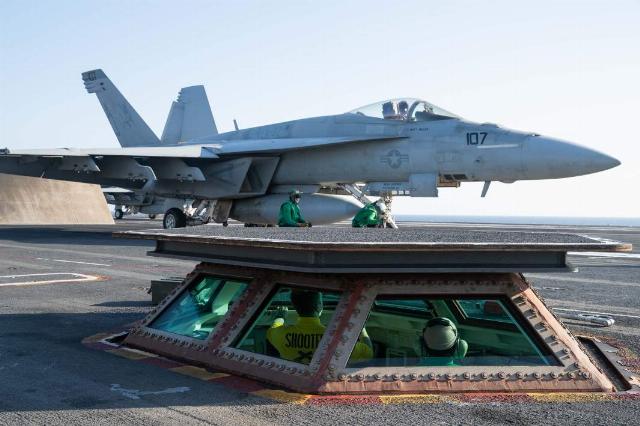
An American F/A-18E fighter-bomber on the deck of the aircraft carrier Gerald Ford
Image source: Photo: Global Look Press/Mc2 Jennifer Newsome/U.S. Navy
There is an aviation wing on board the aircraft carriers, which includes four squadrons of F/A-18E or F Super Hornet aircraft with a total of 48 units. There are also four EF-18G Growler electronic warfare aircraft, four E-2 Hokai long-range radar detection and control aircraft, a pair of transport aircraft and several SH-60 Seahawk helicopters in various modifications. Such an air group can independently conduct high-intensity combat operations. Accordingly, 96 combat aircraft are on board the Chester Nimitz and Carl Vinson. The Gerald Ford belongs to a new generation of American aircraft carriers, and a squadron of F-35C aircraft is already based on it.
At the same time, the key US base in the region of Diego Garcia is located in the Indian Ocean, it has an airfield and warehouses for storing weapons and ammunition. Accordingly, aircraft carrier groups can quickly replenish their stocks of both fuel and aviation weapons.
Iranian Navy
The Navy of the Islamic Republic consists of two components. One is the Navy of the army, and the other component is the naval forces of the IRGC. Both components are mainly represented by small warships and boats. The strength of the IRGC Navy is the presence of a large number of attack boats of various types and sizes (several hundred) and a variety of coastal missile systems with anti-ship missiles. At the same time, such weapons themselves are hidden in underground cities, recently shown on Iranian television, which dramatically increases their survival rate. In addition, the IRGC Navy has four catamaran-type missile corvettes "Shahid Soleimani" (can carry six cruise missiles with a range of up to 700 km and other missile weapons). Although the speed of these ships is unknown, due to their design they can move quite fast, for example, the Russian missile corvette catamaran type "Bora" project 1239 can squeeze a speed of 55 knots, that is, about 100 km / h. The IRGC Navy has other missile boats, as well as several support ships equipped on the basis of large merchant vessels such as tankers or container ships. Such support vessels can carry on board a wide range of drones, combat boats and a variety of missiles.
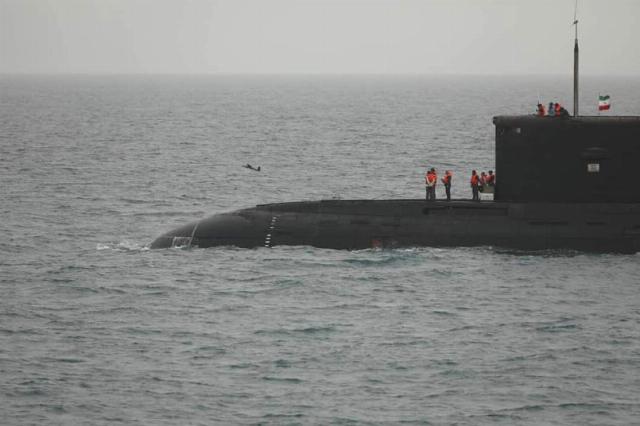
The Iranian submarine Fateh
Image source: Photo: Global Look Press/Iranian Army Office
The Iranian Navy has three Project 877 submarines built in Russia in the first half of the 1990s. The submarine fleet also includes the Fateh submarine and about 16 small submarines. The surface forces of the Iranian army are represented by frigates and missile destroyers of the Alvand and Mudge types.
Iran has a large number of S-701, S-704, S-802 and other anti-ship missile launchers with a range of up to 700 km. Iran may also use anti-ship ballistic missiles.
Possible scenarios of military action
So far, the only scenario that seems most likely is for the United States to participate in the Iran-Israel conflict, namely, the use of B-2A Spirit strategic bombers as the carrier of the GBU-57. This is the world's most powerful non-nuclear bomb weighing more than 13 tons, specially designed to destroy buried targets (command posts or underground factories) on enemy territory. The bomb is capable of penetrating earth, concrete or stone to a depth of 100 m and then producing an explosion. A number of Iranian nuclear program plants are located in such deep locations. The existing Israeli Air Force weapons are not capable of damaging such facilities.
In this case, aircraft from aircraft carriers will be used to create entry and exit corridors for "Spirituals" in Iran, as well as to defeat the air defense system, create electronic jamming or to fight the remaining Iranian fighters. The Islamic Republic has a batch of American F-14 Tomcat fighters delivered back in the time of the Shah, as well as an unknown number of Su-35S fighters recently received from Russia, which proved themselves well in a special military operation. There are 20 of the most insanely expensive (more than $2 billion in value) B-2A in the US Air Force.
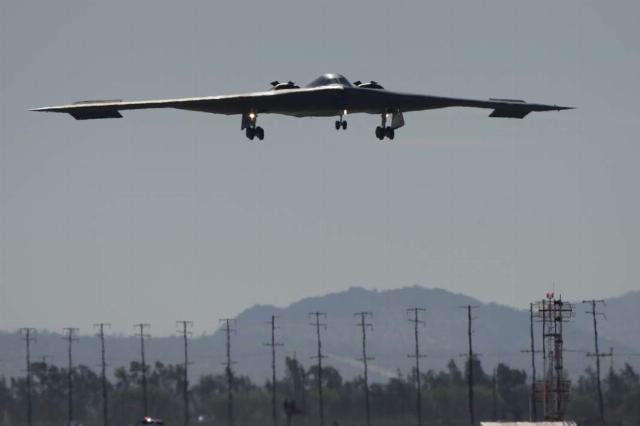
The American stealth strategic bomber B-2A Spirit
Image source: Photo: Global Look Press/Gene Blevins
The use of aircraft carrier air groups for strikes on the territory of Iran does not seem so important yet. The Israeli Air Force, with six hundred planes and helicopters, still clearly holds the skies over Iran in its hands and does not need additional help. At the same time, the Israeli Air Force did not strike the Iranian Navy, they are clearly not a priority.
One can imagine such a scenario of hostilities: if the United States begins to participate in the conflict, depending on how close their ships approach Iranian waters, Iran will try to use its existing submarines capable of operating in the Arabian Sea, high-speed catamaran missile boats, as well as a wide range of anti-ship and ballistic missiles available to it. The submariners will most likely die heroically. The US Navy is well aware of the capabilities of the Project 877 submarines (they were in service with the Polish and Romanian Navies) and are very good at anti-submarine warfare. But if the Iranians manage to covertly deploy launchers and form a salvo of hundreds of anti-ship missiles, then the aircraft carrier's air defense may not be able to resist. At the same time, Iran will not use its destroyers or frigates, as well as support ships from the IRGC Navy. The risk of losing such piece ships is very high for him.

An Iranian small submarine and a small IRGC warship
Image source: Photo: TASS/Abaca Press
Of course, there is a threat that the IRGC Navy will block the Strait of Hormuz, and they have clearly been preparing for this in recent years by building a fleet of various boats and anti-ship missile launchers. The Gulf states export a significant amount of oil and LNG through the strait, with most of the shipments going to Asian countries (82%) and the rest to Europe. Every fourth cubic meter of LNG goes to China. Such a blockade will undoubtedly provoke full-scale military operations of a different nature.
Dmitry Boltenkov
